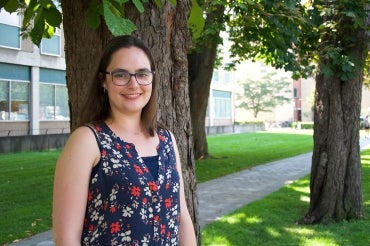U of T biostatistician uses big data to shed new light on chronic diseases

Published: September 27, 2018
Big data has the potential to create new life-saving knowledge in medicine and health, but only if we know how to make sense of large data sets.
And that’s what biostatistician Nathalie Moon has set out to do.
Moon’s latest research empowers medical professionals to gain critical insights by helping them decide how much data to collect – and which kind. A recent University of Toronto hire with a focus in teaching, she's also making an impact by passing her knowledge along to the next generation of statisticians.
For the last five years, Moon, who joined U of T’s department of statistical sciences as an assistant professor this summer, has been working with researchers at the Centre for Prognosis Studies in the Rheumatic Diseases (CPSRD) at Toronto Western Hospital. The centre closely monitors patients suffering from rheumatic disorders – conditions causing chronic pain of the joints and connective tissue – to gain insights into the progression of disease and to improve treatment. Moon leveraged her statistical skills to design research studies that produce accurate results while making efficient use of resources.
Dee Keilholz of the department of statistical sciences spoke to Moon about her latest research project and her passion for teaching students.
What does a biostatistician do?
A biostatistician develops statistical methods and applies them to address problems in areas such as medicine, biology and health. A big part of my work revolves around designing research studies and, to some degree, analyzing data related to biological processes.
Tell me a bit more about your research with the centre. What was the focus of your research and what problems were you trying to solve?
My research looked at three distinct problems, all under the umbrella of understanding the progression of chronic diseases such as psoriasis and psoriatic arthritis – conditions that cause inflammation of the skin and joints respectively.
One part focused on patients who develop a pretty painful, disabling complication called arthritis mutilans. CPSRD follows patients over time and tracks if they develop this complication. However, some patients stop showing up for follow-up appointments, which leads to loss of information. We just don’t know if those patients developed this complication. So, CPSRD launched so-called “tracing studies”, to track down these “lost” patients to see what happened to them. But what if you have hundreds of patients who dropped out, and you only have resources to track down 50? That’s where my research comes in. I basically looked at the data we had on these individuals before they dropped out to figure out who we should focus our resources on.
Another question was around composition of study cohorts – the group of people who participate in these studies. If you want to track the progression of a disease over a patient’s lifetime, that might mean you have to follow that patient for 20 or 30 years. That’s very expensive, and you have to wait a long time to get results. That’s why I looked into designing studies where you don’t have to track people for decades but still get good estimates by recruiting some patients in the early stages of a disease and others from later stages. I showed that this can lead to large savings without compromising the quality of the estimates.
What motivates you to do this type of research?
I prefer working in an area where I can see the link between what I am doing and its usefulness in real life. I was hooked on biostatistics when I took my first course in survival analysis at Queen’s University, which led me to pursue graduate studies in biostatistics at the University of Waterloo. To give an example, survival analysis looks at questions such as cancer patients and the impact of tumor size on patient survival. I just had that “aha” moment where I realized how relevant these questions are, and I wanted to learn how to answer them.
You’ve just started working at U of T as an assistant professor with a focus in teaching. What interested you in taking on this role?
I’m an assistant professor in the teaching stream, which means I will spend most of my time teaching students. I first taught a course during my PhD and it made me realize how much I enjoy helping students learn and encouraging them to try different things. There’s such a variety of career opportunities in statistics, and I like being part of that journey of figuring out what’s right for them. It’s making a different kind of impact than the research I did during my PhD.
I really look forward to teaching my first- and fourth-year courses this term. I think my students are going to benefit from me being a researcher but also a teacher, because it means that I can bring that research experience to the classroom.


